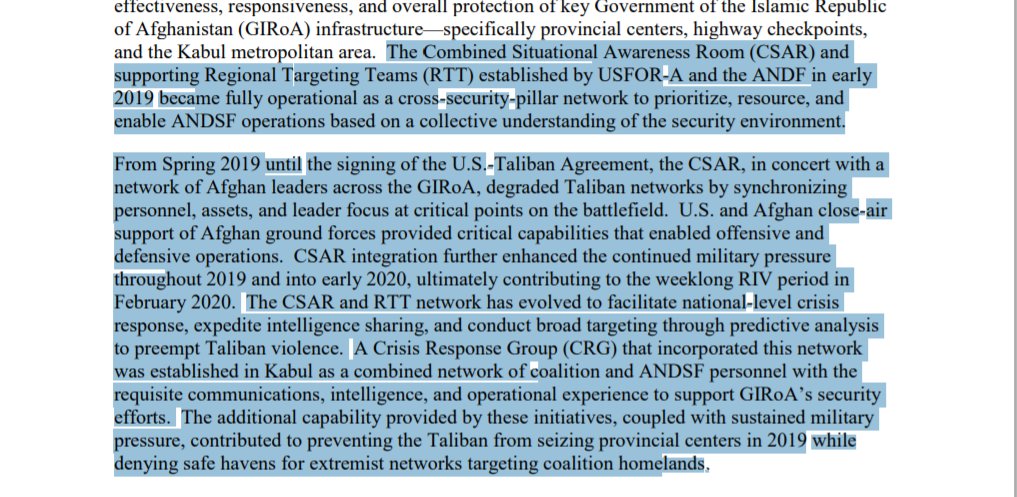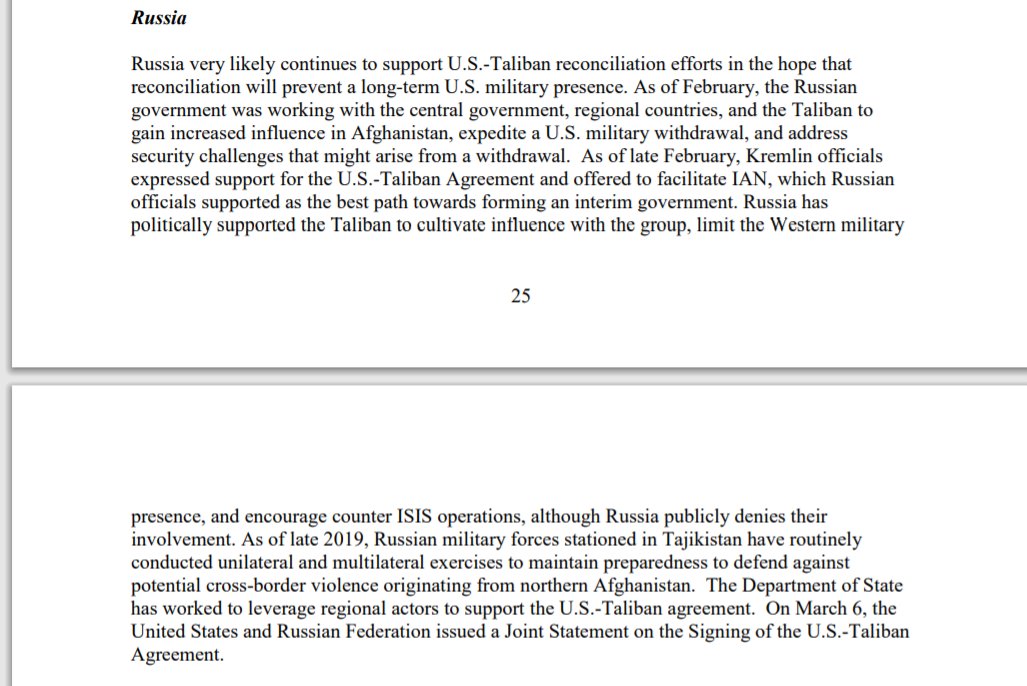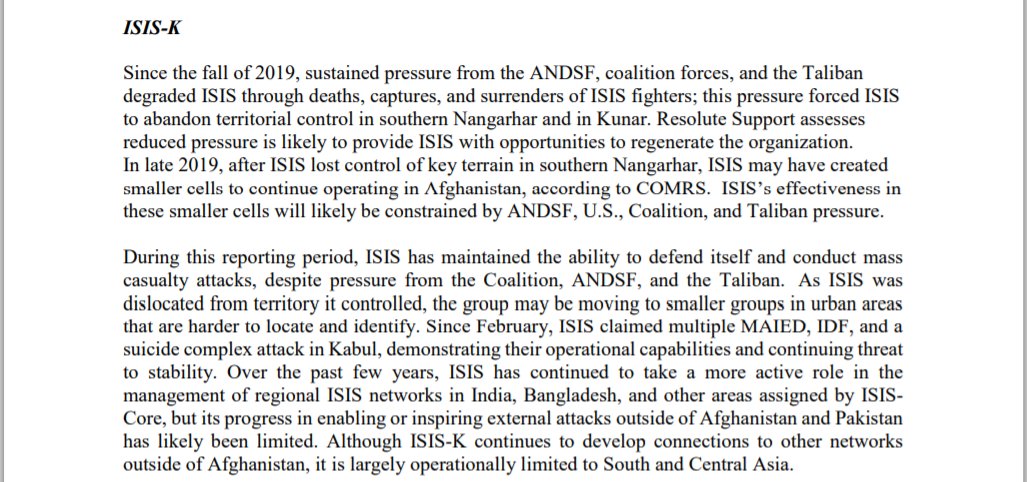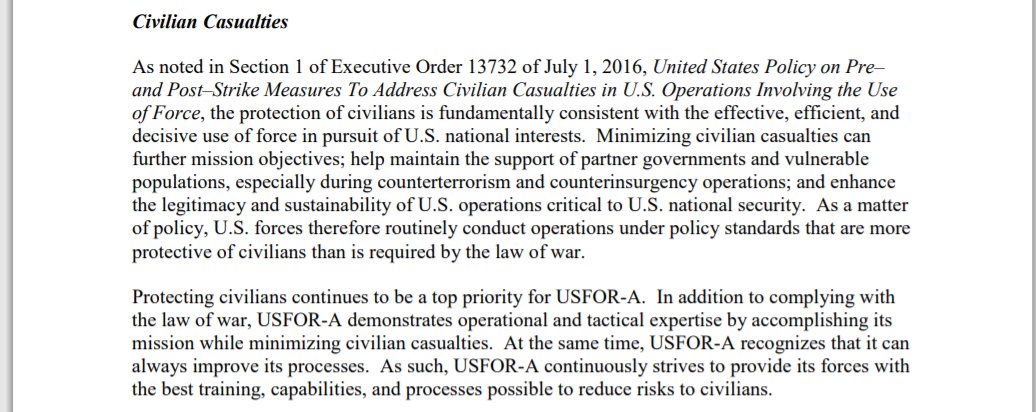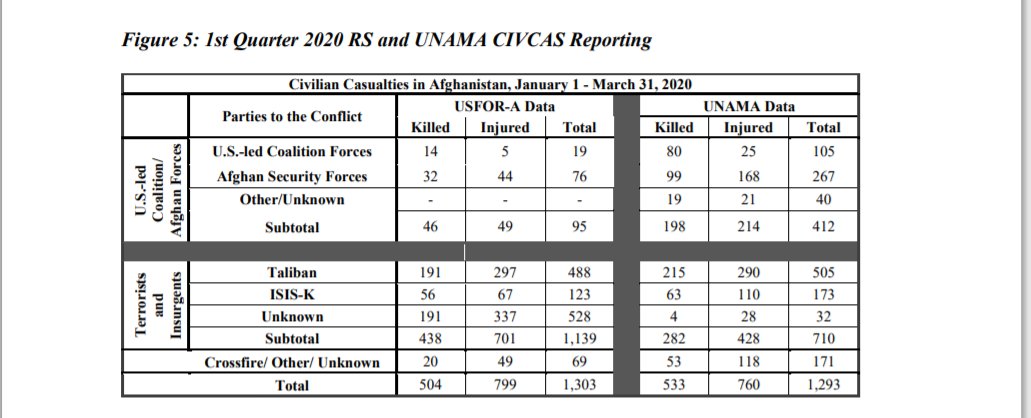Quick thoughts on the latest DoD Report. THREAD  https://abs.twimg.com/emoji/v2/... draggable="false" alt="👇" title="Rückhand Zeigefinger nach unten" aria-label="Emoji: Rückhand Zeigefinger nach unten">
https://abs.twimg.com/emoji/v2/... draggable="false" alt="👇" title="Rückhand Zeigefinger nach unten" aria-label="Emoji: Rückhand Zeigefinger nach unten">
Semi-Annual Report: Enhancing Security and Stability in Afghanistan https://www.defense.gov/Newsroom/Releases/Release/Article/2243572/semi-annual-report-enhancing-security-and-stability-in-afghanistan/#.Xv6RTDw8T04.twitter">https://www.defense.gov/Newsroom/...
Semi-Annual Report: Enhancing Security and Stability in Afghanistan https://www.defense.gov/Newsroom/Releases/Release/Article/2243572/semi-annual-report-enhancing-security-and-stability-in-afghanistan/#.Xv6RTDw8T04.twitter">https://www.defense.gov/Newsroom/...
MILITARY POSTURING:
Report states that AFG government controls all major provincial and populations centres, as well as most district centres and major portions of major lines of communications. Adds that Taliban contest several portions of lines of communications.
Report states that AFG government controls all major provincial and populations centres, as well as most district centres and major portions of major lines of communications. Adds that Taliban contest several portions of lines of communications.
This is a reformulation of AFG govt and US strategy that as long as the govt can control these major centres, the Taliban are free to roam in the rural areas. IMO this has been one of the worst strategies formulated.
The ANDSF are dispersed across defensive lines that stretch across vast expanses of the country. The Taliban on the other hand, are free to roam across virtually the entire country. They can simply avoid ADNSF positions when they don& #39;t want to engage.
And if they intend to engage, all they simply coalesce their force, mine potential lines of reinforcement, and attack isolated checkpoints who are no more than sitting ducks – outnumbered and outgunned.
Were it not for US airpower, the strategy would have long ago resulted in a precipituous collapse of entire defence lines.
For now, Taliban continue to hack away at lines of communications so that should they need to, they can shut these lines as potential reinforcement paths.
For now, Taliban continue to hack away at lines of communications so that should they need to, they can shut these lines as potential reinforcement paths.
From this section I gather that US is still very much in the & #39;thick of things& #39; in AFG.
They are involved in planning to identify and target militants; in providing critical mass in key theatres; and in preventing major Taliban advances.
They are involved in planning to identify and target militants; in providing critical mass in key theatres; and in preventing major Taliban advances.
This section sheds some light on when US forces will engage Taliban in spite of the agreement. If provincial centres, highway checkpoints or the Kabul metropolitan areas are attacked then US engaged through CSAR or RTT.
Not sure if I a misreading this, but if accurate, this still gives Taliban a lot of military room to manoeuvre.
Report notes that since agreement, TB avoided sophisticated attacks in urban centres and have not attacked US or Coalition. Primarily targeting ANDSF in rural areas. Although TB has also attacked several provincial centres. Does not state the intensity of attacks or intentions.
ANDSF CASUALTIES:
Report says ANDSF casualties have generally reduced since the agreement. Direct attacks on checkpoints is largest factor in casualties, followed by IED attacks and mines.
Report says ANDSF casualties have generally reduced since the agreement. Direct attacks on checkpoints is largest factor in casualties, followed by IED attacks and mines.
While time-period might not overlap with the claim of Afghan govt that ANDSF suffered highest casualties in the final week of June, it points to a general trend of reduced casualties. https://twitter.com/HabibKhanT/status/1274945394208841729">https://twitter.com/HabibKhan...
RUSSIA:
Report identifies various countries that continue to provide support to the Taliban. Russia is interesting due to the recent bounties claim.
Report identifies various countries that continue to provide support to the Taliban. Russia is interesting due to the recent bounties claim.
Russian objectives identified as a) expediting US withdrawal; b) increasing influence with various actors, including TB; & c) maintaining preparedness for any cross-border intrusions into Central Asia.
This narrative seems to run counter to that built up by the bounties claim.
This narrative seems to run counter to that built up by the bounties claim.
AL-QAEDA:
Claims AQ continues to maintain ties with TB. AQ core has a few members remaining but largely focussed on survival. Activities in region are left to the local branch – AQIS. AQIS lacks capacity to pose a threat unless they receive support from the Taliban
Claims AQ continues to maintain ties with TB. AQ core has a few members remaining but largely focussed on survival. Activities in region are left to the local branch – AQIS. AQIS lacks capacity to pose a threat unless they receive support from the Taliban
Noteworthy that Taliban very swiftly published a statement rejecting all ties with AQIS. https://twitter.com/Zabehulah_M33/status/1278687902705344516">https://twitter.com/Zabehulah...
ISKP:
ISKP has been degraded significantly and lost all territorial control in Nangarhar and Kunar. The easing of pressure however might allow them to regroup and revitalise.
ISKP has been degraded significantly and lost all territorial control in Nangarhar and Kunar. The easing of pressure however might allow them to regroup and revitalise.
ISKP continues to have capacity to launch sophisticated attacks. Smaller cells have begun dispersing in urban centres. This might indicate increasing ISKP attacks in Kabul and other centres. Significantly, no mention of accommodation between ISKP and Taliban, including Haqqani.
CIVCAS:
US completely exonerates itself with regards to CIVCAS. No surprise there.
According to each belligerent, they cause virtually none civilian casualties and it is all the others& #39; fault.
US completely exonerates itself with regards to CIVCAS. No surprise there.
According to each belligerent, they cause virtually none civilian casualties and it is all the others& #39; fault.
I found this chart very interesting. It compared CIVCAS attributed to various parties as assigned by USFOR-A & UNAMA.
Huge discrepancy between those assigned to ISAF in the two charts.
Huge discrepancy between those assigned to ISAF in the two charts.

 Read on Twitter
Read on Twitter
